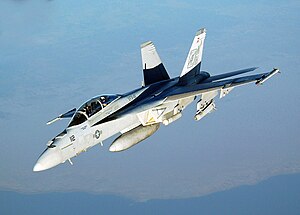F-18 Super Hornet
| F/A-18E/F Super Hornet | |
|---|---|
 |
|
| A U.S. Navy F/A-18F Super Hornet on a mission over the Persian Gulf in September 2005 | |
| Role | Carrier-based multirole fighter |
| National origin | United States |
| Manufacturer |
McDonnell Douglas Boeing Defense, Space & Security |
| First flight | 29 November 1995 |
| Introduction | 1999 |
| Status | In service |
| Primary users |
United States Navy Royal Australian Air Force |
| Produced | 1995–present |
| Number built | 500 as of April 2011 |
| Program cost | Total procurement: US$48.09 billion (through FY2011) |
| Unit cost |
US$70.5 million (2017 flyaway cost)
|
| Developed from | McDonnell Douglas F/A-18 Hornet |
| Variants | Boeing EA-18G Growler |
The Boeing F/A-18E and F/A-18F Super Hornet are twin-engine carrier-capable multirole fighter aircraft variants based on the McDonnell Douglas F/A-18 Hornet. The F/A-18E single-seat and F/A-18F tandem-seat variants are larger and more advanced derivatives of the F/A-18C and D Hornet. The Super Hornet has an internal 20 mm M61 rotary cannon and can carry air-to-air missiles and air-to-surface weapons. Additional fuel can be carried in up to five external fuel tanks and the aircraft can be configured as an airborne tanker by adding an external air refueling system.
Designed and initially produced by McDonnell Douglas, the Super Hornet first flew in 1995. Low-rate production began in early 1997 with full-rate production starting in September 1997, after the merger of McDonnell Douglas and Boeing the previous month. The Super Hornet entered service with the United States Navy in 1999, replacing the Grumman F-14 Tomcat, which was retired in 2006; the Super Hornet serves alongside the original Hornet. The Royal Australian Air Force (RAAF), which has operated the F/A-18A as its main fighter since 1984, ordered the F/A-18F in 2007 to replace its aging F-111C fleet. RAAF Super Hornets entered service in December 2010.
The Super Hornet is an evolutionary redesign of the McDonnell Douglas F/A-18 Hornet. The Super Hornet's unique wing and tail configuration can be traced back to an internal Northrop project P-530, c. 1965; this had started as a substantial rework of the lightweight F-5E with a larger wing, twin tail fins and a distinctive leading edge root extension (LERX). Later flying as the Northrop YF-17 "Cobra", it competed in the United States Air Force's Lightweight Fighter (LWF) program to produce a smaller and simpler fighter to complement the larger McDonnell Douglas F-15 Eagle; the YF-17 lost the competition to the YF-16.
...
Wikipedia
